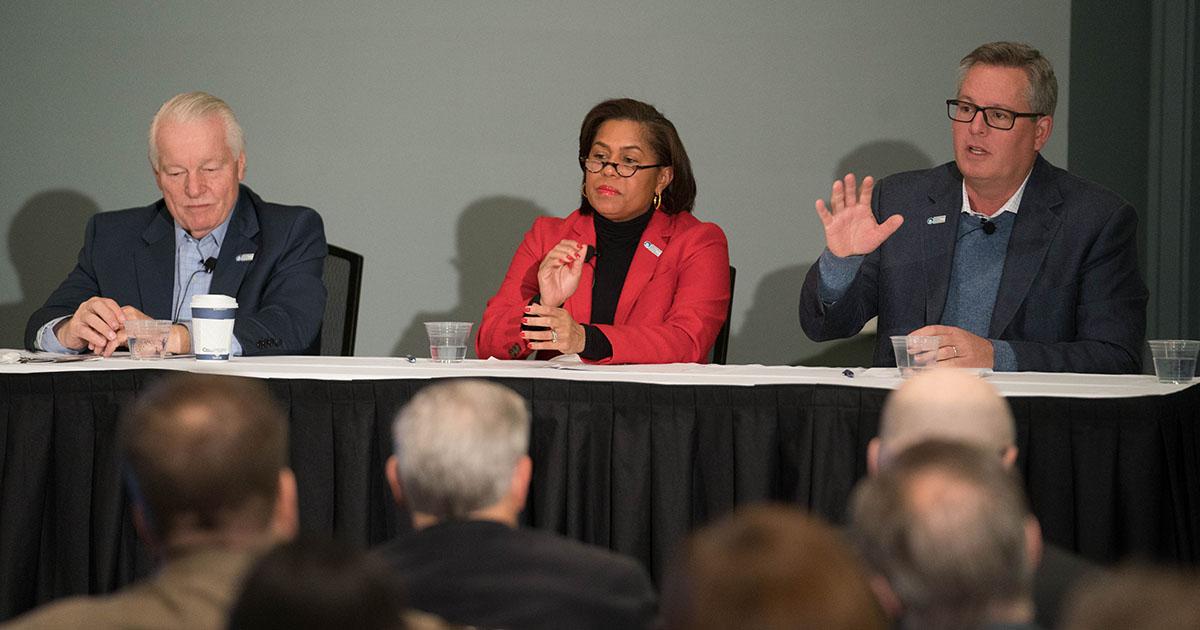Photo: Jacob Slaton
It’s happening in Nashville. It’s happening in Miami. It’s happening across the United States and around the world, and reaffirms what many meeting, event, travel and hospitality industry leaders and professionals know—the meeting industry has strengthened and is an important contributor to the U.S. and worldwide economies.
Julie Coker Graham, president and CEO of the Philadelphia CVB and co-chair of the Meetings Mean Business coalition, said Tuesday that preliminary data from an upcoming Meetings Significance Study showed increases in the number of meetings, participants and spending.
“We know the value of face to face,” she said during a press conference at the Professional Convention Management Association (PCMA) Convening Leaders conference at the Music City Center in Nashville.
“We have to talk about economic value, jobs, taxes and make sure it’s being heard by those who influence our industry. Our industry is at a pivotal point and advocacy is the key to building capacity.”
The study tracked 2016 data and preliminary results reveal:
• There were 1.9 million meetings, including more than 250 million participants, representing a 10 percent growth from 2012.
• There was more than US$330 billion in direct spending or business sales—an amount greater than the sales of businesses in the air, rail and water transportation sectors combined (also greater than the business output of the arts, entertainment and recreation sector).
• International meeting participation surpassed 6 million, with international participant spending in the U.S. reaching $18.3 billion.
• The U.S. meeting industry continues to grow across all segments and all major metrics, particularly international participation.
“This data is critical for us to tell our story,” said Graham, who co-chairs the coalition with Paul Van Deventer, president and CEO of MPI.
The industry need look no further than the success in cities such as Nashville and Miami as examples of the growth.
Butch Spyridon, president and CEO of the Nashville Convention & Visitors Corp., said one-third of all visitor dollars spent in Tennessee are in Nashville and Davidson County, resulting in a $6 billion economic impact, with 40 percent of that coming from meetings and events.
The city just added 1,200 hotel rooms, bringing the citywide total to more than 28,300, and another 5,300 rooms are under construction over the next two years.
Bill Talbert III, president CEO of the Greater Miami CVB, shared a video on the current $620 million expansion and renovation of the Miami Beach Convention Center. The project includes nearly 500,000 square feet of renovated exhibit space, a state-of-the-art, 60,000-square-foot grand ballroom, additional meeting rooms with flexible arrangements, a 20,000-square-foot glass rooftop junior ballroom, advanced technology and new versatile indoor/outdoor public spaces. The reimagined Miami Beach Convention Center is unveiling later this year, but has already booked business in the new space.
“We are a $2 billion industry in Miami,” Talbert said. “Meetings Mean Business is a part of our DNA.”
Roger Dow, president and CEO of the U.S. Travel Association, said 35 countries have signed up to participate in this year’s Global Meetings Industry Day (GMID) on April 12. GMID brings together leaders from across the meeting and event industry to showcase the real impact that business meetings, conferences, conventions, incentive travel, trade shows and exhibitions have on people, business and communities. Last year, this international day of advocacy involved more than 120 events held across six continents.
Richard Harper, executive vice president at HelmsBriscoe, was honored Tuesday for his two-year term as co-chair of the Meetings Mean Business coalition. He has been an ardent supporter of the coalition since its inception.
“It’s been an honor to be co-chair the last two years,” he said. “More people are starting to see what this is doing for the industry. Today we have the privilege of working in one of the biggest industries in the world.”



